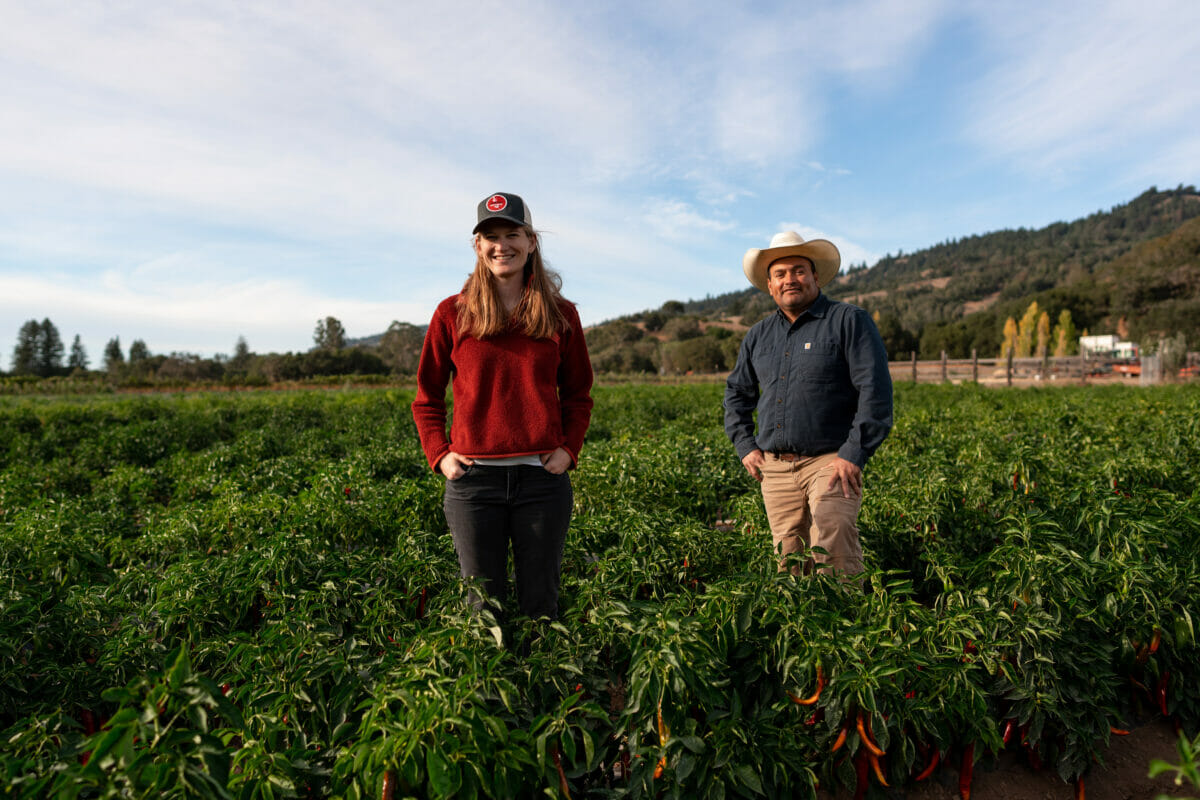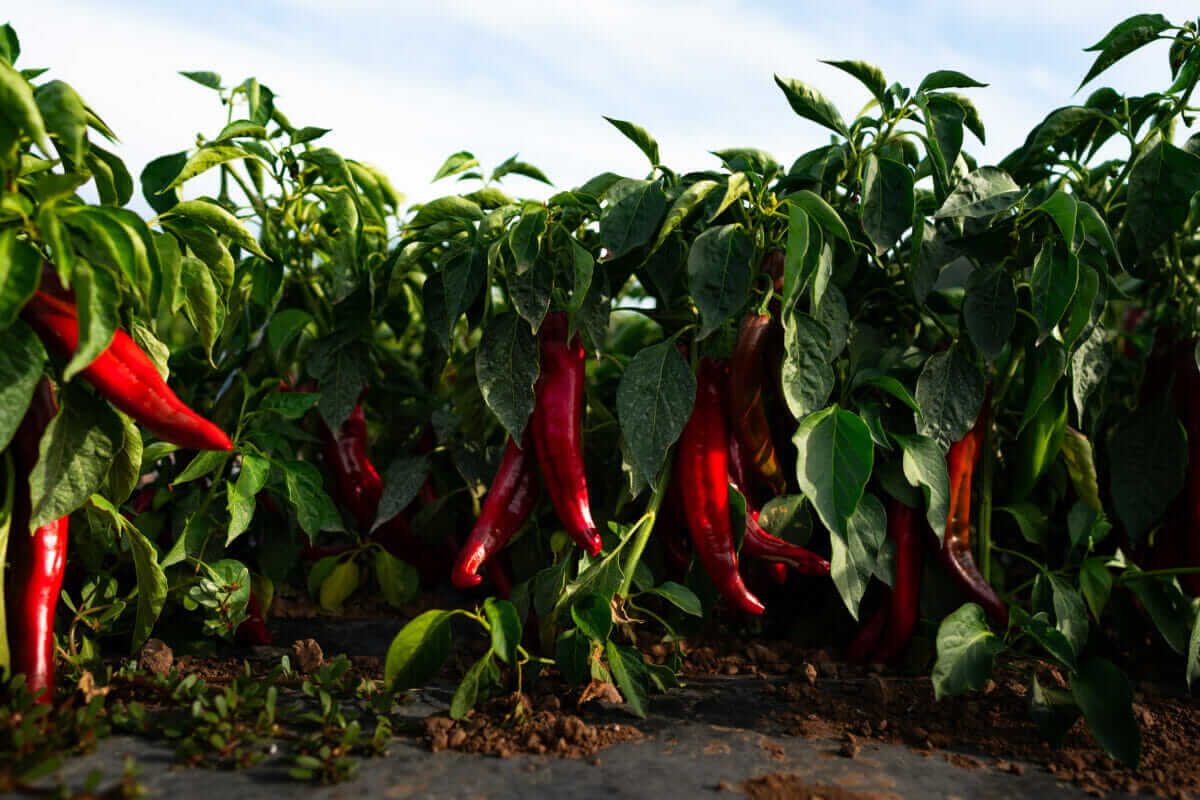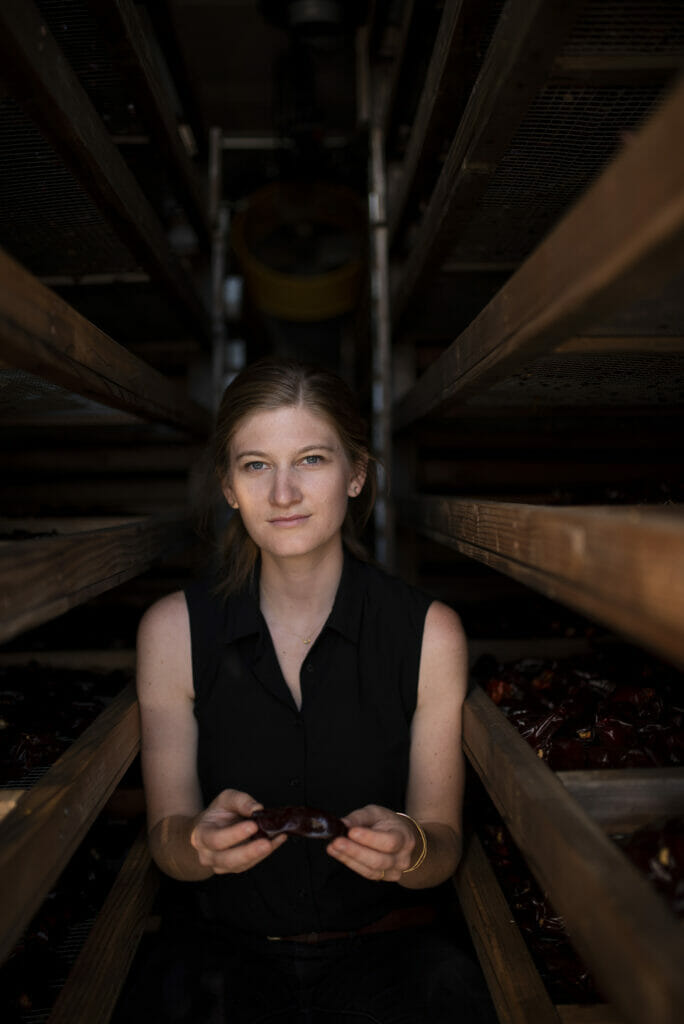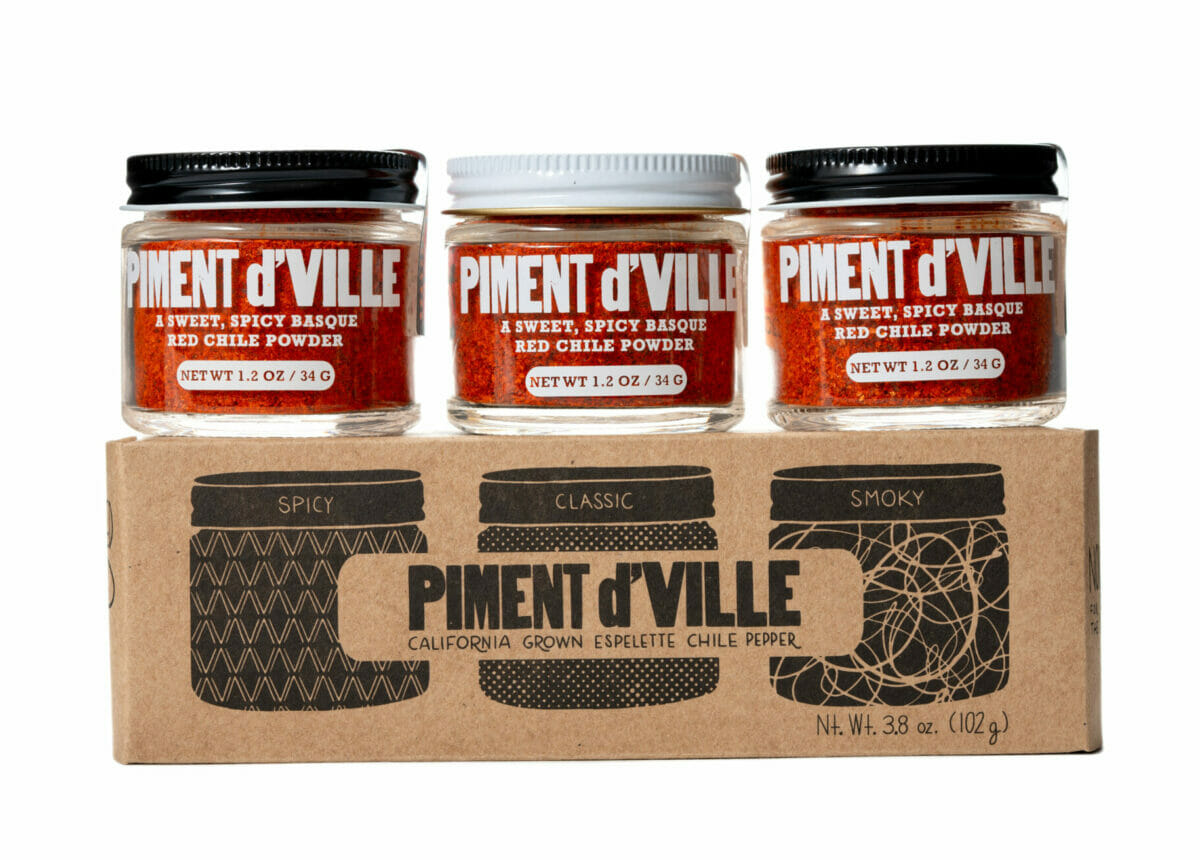Creating a New Route for a Traditional Basque Spice
When she couldn’t find a local source for Piment d’Espelette, chef-turned-farmer Krissy Scommegna set out to grow her own.
Creating a New Route for a Traditional Basque Spice
When she couldn’t find a local source for Piment d’Espelette, chef-turned-farmer Krissy Scommegna set out to grow her own.

Krissy Scommegna, founder of Boonville Barn Collective, and Nacho Flores grow Espelette peppers in California.courtesy of Nik Z Photo.
Basque people love their peppers. Although not indigenous to the region, which straddles the border between France and Spain, peppers were first brought from the Americas during the 16th century, and they quickly became a key ingredient in several local dishes. The Espelette pepper, named for the community in France where it is cultivated, is beloved in the region, with a famous annual festival held in its honor. It’s used to make Piment d’Espelette, a spice so essential and prominent that it has replaced black pepper in some recipes.
Krissy Scommegna, founder of Boonville Barn Collective, first learned about Piment d’Espelette while working in the kitchen at the Boonville Hotel in California’s Mendocino County. “We used this spice in basically everything that we cooked,” she explains. “I came to love it.”
The hotel, deep in Wine Country, tried to source as much local produce as possible for its restaurant. Scommegna thought, “Why not do the same with spices?” The Espelette pepper, a cornerstone of the restaurant’s cooking, was expensive to import, and Northern California’s warm days and cool nights didn’t seem too dissimilar from the climate of the mountainous border between France and Spain where the spice came from. So, with farm foreman Nacho Flores, she planted a small number of pepper plants on a bit of land near the hotel.
Ten years later, Scommegna, Flores and a small team tend three acres of peppers and have made a name for their California-grown Espelette. The chili is grown, dried, ground and packaged onsite. Similar to Champagne, Piment d’Espelette is protected and classified as an AOC product, which means it can only be called such if grown in its namesake locale in France. So Boonville Barn Collective calls its pepper Piment d’Ville, a nod to Boonville, where the peppers grow.

When people buy it for the first time, Scommegna encourages them to put down the pepper mill and see how the chili powder transforms dishes with its a-little-spicy, a-little-sweet, rich and deep tomato-y flavor. “Stop using black pepper for a week,” she tells them. “[Piment d’Ville] shapeshifts into different flavors, depending on what you’re cooking.”
In addition to nailing down the right growing and preservation methods for the peppers, finding balance on the 10-acre farm in Northern California’s Anderson Valley took time. “It’s been 10 years of trial and error, trying to figure out what we need, whether it’s how we were going to dry”—starting with an oven and moving up to a small dehydrator to a bigger dehydrator to a retrofitted shipping container—to “working to create a sustainable farm in terms of how we grow and how we structure our business.”

When growing, drying and packaging is all done on premises, creating such a sustainable farm and business can be a balancing act. During peak harvest time, Scommegna spends seven hours in the fields, then heads inside to the computer for several more hours, writing email newsletters, making sales or working on partnerships with other small, women-owned food brands. Her husband and co-owner, Gideon Burdick, handles other parts of the business side such as payroll and invoicing (when he’s not responding to calls as a member of the local volunteer fire department).
On the farming end, sustainability has meant not only abstaining from using synthetic fertilizers, herbicides or pesticides but also expanding beyond the signature chili powder into other ground peppers, such as poblano and comapeño chilis (Boonville is the only US grower of the latter, a rare chili grown in the Veracruz mountains in Mexico), and whole dried chilis, too. They also now rotate their fields between peppers and heirloom beans in an effort to prevent the land from going fallow and creating additional shelf stable goods to sell. Among the bean varieties are Peruano beans, grown on foreman Nacho Flores’ suggestion. A staple in Mexican cooking (especially in Michoácan, Jalisco and Guanajuato), she hopes they resonate with the many Mexican-Americans in the Anderson Valley, many of whom are from Michoácan.
Plus, Scommegna points out, beans go well with chilis. “Whatever we’re growing together cooks well together,” she says, never far from her chef roots. (The farm also has strawberries for lucky locals, some olive trees for olive oil, and it experiments with other brands on partnerships such as a citrus chili marmalade.)
When the coronavirus pandemic struck, Scommegna and Burdick shifted once again, this time from mostly selling Piment d’Ville wholesale to restaurants to getting peppers into the hands of home cooks via online direct-to-consumer sales and retail shops. Their customer base is now made up of more than 500 restaurants and around 100 retailers nationwide, in addition to the many home cooks who buy directly from Boonville Barns.

Scommegna enjoys connecting with them all, especially by writing farm updates on the company’s website and in their newsletters. “It’s not just ‘buy this product.’ It’s ‘this is what we’re excited about, this crop is coming along.’ It’s fun to connect with people online, teaching them about new chilis they might have never heard of before.” There are recipes available on the site, too.
As for other California farmers, Scommegna hopes more will look to strengthen their resilience in the face of the many challenges they face by diversifying crops and product offerings. “I think they’re going to realize that adding some sort of spices or drying crops is a beneficial way to have shelf stable goods throughout the year,” she says.
Not that Boonville’s chilis sit on the shelf for long—jars of Piment d’Ville are often shipped out within a month of it being harvested, dried and packed up. The harvest date is printed on the container, not only emphasizing its freshness but also that each batch is different. “People will be like, ‘I tried this and it’s spicier than last year,’” Scommegna says. “It speaks to the pepper and the fact it’s a living, breathing organism, and when people recognize that, it’s exciting. It’s really special to be able to share that.”
Follow us
This work is licensed under a Creative Commons Attribution-NoDerivatives 4.0 International License.
Want to republish a Modern Farmer story?
We are happy for Modern Farmer stories to be shared, and encourage you to republish our articles for your audience. When doing so, we ask that you follow these guidelines:
Please credit us and our writers
For the author byline, please use “Author Name, Modern Farmer.” At the top of our stories, if on the web, please include this text and link: “This story was originally published by Modern Farmer.”
Please make sure to include a link back to either our home page or the article URL.
At the bottom of the story, please include the following text:
“Modern Farmer is a nonprofit initiative dedicated to raising awareness and catalyzing action at the intersection of food, agriculture, and society. Read more at <link>Modern Farmer</link>.”
Use our widget
We’d like to be able to track our stories, so we ask that if you republish our content, you do so using our widget (located on the left hand side of the article). The HTML code has a built-in tracker that tells us the data and domain where the story was published, as well as view counts.
Check the image requirements
It’s your responsibility to confirm you're licensed to republish images in our articles. Some images, such as those from commercial providers, don't allow their images to be republished without permission or payment. Copyright terms are generally listed in the image caption and attribution. You are welcome to omit our images or substitute with your own. Charts and interactive graphics follow the same rules.
Don’t change too much. Or, ask us first.
Articles must be republished in their entirety. It’s okay to change references to time (“today” to “yesterday”) or location (“Iowa City, IA” to “here”). But please keep everything else the same.
If you feel strongly that a more material edit needs to be made, get in touch with us at [email protected]. We’re happy to discuss it with the original author, but we must have prior approval for changes before publication.
Special cases
Extracts. You may run the first few lines or paragraphs of the article and then say: “Read the full article at Modern Farmer” with a link back to the original article.
Quotes. You may quote authors provided you include a link back to the article URL.
Translations. These require writer approval. To inquire about translation of a Modern Farmer article, contact us at [email protected]
Signed consent / copyright release forms. These are not required, provided you are following these guidelines.
Print. Articles can be republished in print under these same rules, with the exception that you do not need to include the links.
Tag us
When sharing the story on social media, please tag us using the following: - Twitter (@ModFarm) - Facebook (@ModernFarmerMedia) - Instagram (@modfarm)
Use our content respectfully
Modern Farmer is a nonprofit and as such we share our content for free and in good faith in order to reach new audiences. Respectfully,
No selling ads against our stories. It’s okay to put our stories on pages with ads.
Don’t republish our material wholesale, or automatically; you need to select stories to be republished individually.
You have no rights to sell, license, syndicate, or otherwise represent yourself as the authorized owner of our material to any third parties. This means that you cannot actively publish or submit our work for syndication to third party platforms or apps like Apple News or Google News. We understand that publishers cannot fully control when certain third parties automatically summarize or crawl content from publishers’ own sites.
Keep in touch
We want to hear from you if you love Modern Farmer content, have a collaboration idea, or anything else to share. As a nonprofit outlet, we work in service of our community and are always open to comments, feedback, and ideas. Contact us at [email protected].by Sophia F. Gottfried, Modern Farmer
December 26, 2021
Modern Farmer Weekly
Solutions Hub
Innovations, ideas and inspiration. Actionable solutions for a resilient food system.
ExploreExplore other topics
Share With Us
We want to hear from Modern Farmer readers who have thoughtful commentary, actionable solutions, or helpful ideas to share.
SubmitNecessary cookies are absolutely essential for the website to function properly. This category only includes cookies that ensures basic functionalities and security features of the website. These cookies do not store any personal information.
Any cookies that may not be particularly necessary for the website to function and are used specifically to collect user personal data via analytics, ads, other embedded contents are termed as non-necessary cookies.
About these Basque peppers I live in Bangladesh & want to grow djfferent types of peppers